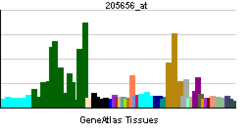- PCDH17
-
Protocadherin 17 Identifiers Symbols PCDH17; PCDH68; PCH68 External IDs OMIM: 611760 MGI: 2684924 HomoloGene: 8700 GeneCards: PCDH17 Gene Gene Ontology Molecular function • calcium ion binding
• protein bindingCellular component • plasma membrane
• integral to membraneBiological process • cell adhesion
• homophilic cell adhesionSources: Amigo / QuickGO RNA expression pattern 
More reference expression data Orthologs Species Human Mouse Entrez 27253 219228 Ensembl ENSG00000118946 ENSMUSG00000035566 UniProt O14917 n/a RefSeq (mRNA) NM_001040429 NM_001013753.2 RefSeq (protein) NP_001035519 NP_001013775.2 Location (UCSC) Chr 13:
58.21 – 58.3 MbChr 14:
84.84 – 84.94 MbPubMed search [1] [2] Protocadherin-17 is a protein that in humans is encoded by the PCDH17 gene.[1][2]
This gene belongs to the protocadherin gene family, a subfamily of the cadherin superfamily. The encoded protein contains six extracellular cadherin domains, a transmembrane domain, and a cytoplasmic tail differing from those of the classical cadherins. The encoded protein may play a role in the establishment and function of specific cell-cell connections in the brain.[2]
References
- ^ Nollet F, Kools P, van Roy F (Jul 2000). "Phylogenetic analysis of the cadherin superfamily allows identification of six major subfamilies besides several solitary members". J Mol Biol 299 (3): 551–72. doi:10.1006/jmbi.2000.3777. PMID 10835267.
- ^ a b "Entrez Gene: PCDH17 protocadherin 17". http://www.ncbi.nlm.nih.gov/sites/entrez?Db=gene&Cmd=ShowDetailView&TermToSearch=27253.
Further reading
- Yagi T, Takeichi M (2000). "Cadherin superfamily genes: functions, genomic organization, and neurologic diversity". Genes Dev. 14 (10): 1169–80. PMID 10817752.
- Suzuki ST (2000). "Recent progress in protocadherin research". Exp. Cell Res. 261 (1): 13–8. doi:10.1006/excr.2000.5039. PMID 11082270.
- Wu Q, Maniatis T (2000). "Large exons encoding multiple ectodomains are a characteristic feature of protocadherin genes". Proc. Natl. Acad. Sci. U.S.A. 97 (7): 3124–9. doi:10.1073/pnas.060027397. PMC 16203. PMID 10716726. http://www.pubmedcentral.nih.gov/articlerender.fcgi?tool=pmcentrez&artid=16203.
- Strausberg RL, Feingold EA, Grouse LH et al. (2003). "Generation and initial analysis of more than 15,000 full-length human and mouse cDNA sequences". Proc. Natl. Acad. Sci. U.S.A. 99 (26): 16899–903. doi:10.1073/pnas.242603899. PMC 139241. PMID 12477932. http://www.pubmedcentral.nih.gov/articlerender.fcgi?tool=pmcentrez&artid=139241.
- Ota T, Suzuki Y, Nishikawa T et al. (2004). "Complete sequencing and characterization of 21,243 full-length human cDNAs". Nat. Genet. 36 (1): 40–5. doi:10.1038/ng1285. PMID 14702039.
- Dunham A, Matthews LH, Burton J et al. (2004). "The DNA sequence and analysis of human chromosome 13". Nature 428 (6982): 522–8. doi:10.1038/nature02379. PMC 2665288. PMID 15057823. http://www.pubmedcentral.nih.gov/articlerender.fcgi?tool=pmcentrez&artid=2665288.
- Suzuki Y, Yamashita R, Shirota M et al. (2004). "Sequence Comparison of Human and Mouse Genes Reveals a Homologous Block Structure in the Promoter Regions". Genome Res. 14 (9): 1711–8. doi:10.1101/gr.2435604. PMC 515316. PMID 15342556. http://www.pubmedcentral.nih.gov/articlerender.fcgi?tool=pmcentrez&artid=515316.
- Gerhard DS, Wagner L, Feingold EA et al. (2004). "The Status, Quality, and Expansion of the NIH Full-Length cDNA Project: The Mammalian Gene Collection (MGC)". Genome Res. 14 (10B): 2121–7. doi:10.1101/gr.2596504. PMC 528928. PMID 15489334. http://www.pubmedcentral.nih.gov/articlerender.fcgi?tool=pmcentrez&artid=528928.
- Kimura K, Wakamatsu A, Suzuki Y et al. (2006). "Diversification of transcriptional modulation: Large-scale identification and characterization of putative alternative promoters of human genes". Genome Res. 16 (1): 55–65. doi:10.1101/gr.4039406. PMC 1356129. PMID 16344560. http://www.pubmedcentral.nih.gov/articlerender.fcgi?tool=pmcentrez&artid=1356129.
- Szafranski K, Schindler S, Taudien S et al. (2007). "Violating the splicing rules: TG dinucleotides function as alternative 3' splice sites in U2-dependent introns". Genome Biology 8 (8): R154. doi:10.1186/gb-2007-8-8-r154. PMC 2374985. PMID 17672918. http://www.pubmedcentral.nih.gov/articlerender.fcgi?tool=pmcentrez&artid=2374985.
Categories:- Human proteins
- Chromosome 13 gene stubs
Wikimedia Foundation. 2010.
